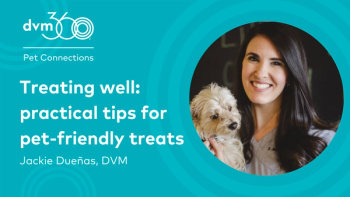
When the pet is obese and the client is oblivious
The battle of the bulge starts with your veterinary clients hearts and minds.
"This box has clearly gotten smaller." (Shutterstock.com)Obesity is an epidemic in the veterinary field, but the biggest barrier you're likely to face in this battle of the bulge isn't the pet's waistline-it's the client's perception, says
While more than half the cats and dogs in the United States are overweight, only half of the owners of these fat pets believe their pets are overweight (even after the veterinarian has discussed the patient's body condition score), and very few have a good understanding of how many calories they're feeding their pets on a daily basis.
So according to Dr. Linder, the key to making a dent in the obesity epidemic isn't solely in feeding the right diet. The solution is a complex one that requires developing mad skills in the areas of communication, education and empathy. We must understand our clients' perceptions and motivations to get them to budge, because until clients understand that a fat pet is a suffering pet, nothing will change.
Will it take some time? Probably.
Is it hard? Maybe-but nobody ever said this profession was easy.
Are we gangsters who can become amazing communicators to eradicate pet obesity and solve world hunger? Yes, we are. (OK, that last part may be a bit strong, but who knows?)
What do your clients say when you break the news that their pet has a weight problem? Here are some of the more common client comments, followed by Dr. Linder's recommendations on how to respond-along with a few tips of my own.
3 critical aspects of a weight-loss plan
1. Trust. Build trust with clients to the point that they would be comfortable telling you they feed their dog Big Macs. Emphasize that you and the client are on the same team in working together for the best health of the pet.
2. Complete diet history. People don't usually overfeed their pets consciously, Dr. Linder says. Get to the bottom of the situation by utilizing open-ended questions, like “What treats do you give?” or “What does your pet's bedtime routine consist of?” Ask about treats, chews, medication administration and supplements. Many clients use food to administer medication, and those calories count. If you don't have time to obtain a full history, ask the client to fill out a diet history (try
3. Follow-up. You have to check in with the client and make adjustments to the diet plan as necessary. Dr. Linder tells clients that the first two weeks are just a test phase-she has no idea what the pet's metabolism is like or whether the pet will lose, gain or stay static, so she sets the client's expectations ahead of time that anything can happen during the first two weeks. Communicate that after the test phase, the goal is for the pet to lose 1 percent of its total body weight every week. (Note: The weight loss safe range is between 0.5 and 2 percent per week. If you go higher, the pet is likely to lose muscle, not fat, and have rebound weight gain.)
“Eh. I don't really care if he's fat. He's happy.”
Here's how Dr. Linder replies to this comment: “Yes, there might be more of him to love, but you'll have less time to love him. A landmark lifetime study of Labrador retrievers showed that dogs live almost two years less if they're overweight.”1
In addition, I tell pet owners that overweight dogs get disease earlier than thin dogs, which costs them more in vet bills and causes unnecessary pain and suffering. I find that this line really hits home for my clients because they don't want to see their pets suffer and they don't want expensive veterinary visits. It's good to know your clients' biggest concerns for their pets.
A caveat: If a client is not ready to address the pet's weight problem, don't push it. You can actually compound the problem or lose the client's trust completely. Just give the client the information and let it be.
“But it's cruel to put her on a diet. I hate being on a diet. I don't want her to suffer.”
Dr. Linder's response: “Actually, pets are happier when they have a healthy weight. They have better energy and less pain from arthritis. Feeding treats is an important part of the human-animal bond, however, and I still want you to have that with your pet. Let's look at some healthier, lower-calorie options.”
Dr. Linder creates daily calorie plans in which patients get 90 percent of their calories from a complete and balanced diet and 10 percent of their calories from treats (if feeding treats is an important part of the client-pet relationship). She also likes to find out what the client's non-negotiables are (i.e. the items they'll feed their pets no matter what you say) and incorporate them into the diet plan. The more you can compromise with your client without putting the pet's health at risk, the better.
“OK. I'll just feed my pet less of his regular food.”
We want to cut calories, not nutrients. Let your clients know that if they have to drastically cut calories, the pet may not get adequate protein or other essential nutrients from a maintenance diet, and this can cause muscle loss instead of fat loss. Weight-loss diets are specially designed to reduce calories and maintain adequate nutrient levels.
Severely obese pets and orthopedic patients on extended cage rest are the best candidates for therapeutic diets. If the main problem is drastic overfeeding or if the pet doesn't have much to lose, OTC diets are adequate.
You. Can. Do. This!
At Fetch dvm360 conference, we're the support system you need. With every conference this year, we intend to nurture your mind (meaning quality CE for days) while also encouraging you to take stock of your physical and emotional health.
When it comes to high-fiber weight-loss diets, research findings vary, says Dr. Linder. Some studies say fiber increases satiety; others say fiber has no effect on satiety at all. So Dr. Linder tells clients that while high-fiber diets may help with satiety, one thing is certain: There will be more stool. That can be a deal-breaker for some clients.
You may find that your clients object to fiber, calling it “filler.” (Thanks, grain-free diet craze.) If that's the case, tell them that it is a filler and that it's intentionally put in the diet to fill the pet up so he won't eat as much.
“I love my roly-poly puppy/kitten. I mean, look at that cute belly!”
There's a reason why human health classes start in elementary school. For us as veterinarians, puppy and kitten visits are the best way to get clients started out on the right nutritional foot.
No time to talk about nutrition? No problem! Train your team to teach clients about body condition scores and nutritional management. Include information in the spay/neuter discharge instructions about the need to reduce caloric intake after surgery (due to hormonal changes, there can be up to a 30 percent decrease in caloric needs), then reinforce this information at the surgical recheck (because, as we all know, pet parents rarely hear what we say the first time).
Dr. Linder recommends
“But my cat is driving me crazy for food at 4 a.m.!”
Food should never come straight from the client, Dr. Linder says, because this solidifies the client as the food source (meaning the cat will of course come yowling whenever she's hungry-even 4 a.m.).
Dr. Linder suggests using a timed feeder scheduled to dispense food five minutes before the cat usually comes whining. She's also a big fan of food puzzles and “no bowl” systems that help control calories and provide environmental enrichment.
In the end, you must change hearts and minds to change waistlines. It may not be easy, but the potential of adding years onto your patients' lives makes all the extra work and awkward conversations worth it.
Reference
1. Kealy RD, Lawler DF, Ballam JM, et al. Effects of diet restriction on life span and age-related changes in dogs. J Am Vet Med Assoc 2002;220(9):1315-1320.
Newsletter
From exam room tips to practice management insights, get trusted veterinary news delivered straight to your inbox—subscribe to dvm360.






